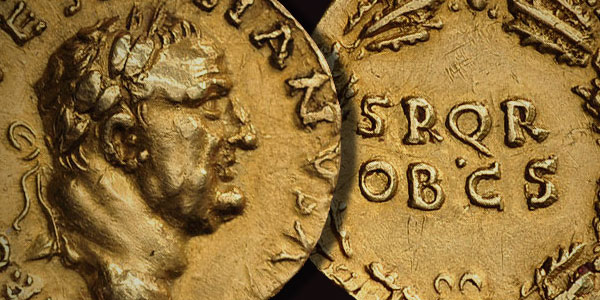
By CoinWeek ….
On MA-Shops.com, Dutch coin dealer Munthandel G. Henzen is currently offering what is possibly only the second known example of a rare gold aureus from early in the reign of Roman emperor Vespasian (ruled 69-79 CE).
Financing the Jewish War
The coin was minted in Antioch on the Orontes, an important Roman city in the province of Syria (Provincia Syria Coele). Struck around 70 CE, it was part of an increase in mint activity to supply coins to Roman soldiers involved in the First Jewish War of 66-73. General and future emperor Vespasian was assigned to the task of quelling the rebellious Jewish nationalists. His son and also future emperor, Titus, served as second-in-command. With the suicide of Emperor Nero in 69, Rome was thrown into a short period of civil war and political instability (the year 69 is often referred to as the “Year of Four Emperors”). Vespasian was eventually proclaimed emperor and left for Rome, leaving Titus in charge, where he famously sacked Jerusalem in 70 CE.
The gold aureus offered here was issued in that same year.
The obverse features a right-facing bust of a middle-aged Vespasian wearing a laurel wreath symbolizing victory. Clockwise along the rim, starting in the lower left, is the inscription IMP • CAES • VESPASIANVS • AVG, which stands for Imperator Caesar Vespasianus Augustus (“Emperor and Caesar Vespasian Augustus”). Beads or dots can be seen in the upper left quadrant; the beads would presumably have encircled the entire side.
The reverse features what is known as the “civic crown”, or corona civica, a wreath of oak leaves that was traditionally given to a Roman citizen who saved the life of another Roman in combat but which was co-opted as a ceremonial honor by the Roman emperors. In the middle of the coin, surrounded by an unusual amount of empty space, are the initials SPQR OB • CS (Senatus Populusque Romanus Ob Cives Servatos, which means “By the Senate and the people of Rome for saving the citizens”). It is a design that feels vaguely familiar to collectors of classic American coins.
This coin’s pedigree goes back to the Biaggi Collection of Gold Roman Coins built by Leo Biaggi de Blasys (1906-1979) over the course of his life. Despite some scratches, primarily on the reverse with its swath of vulnerable empty space, the strike is exceptionally sharp for an almost 2,000-year-old gold coin produced by a provincial mint during wartime.
* * *
About MA-Shops
 MA-Shops is an internet marketplace headquartered in Europe. MA-Shops has assembled a network of reputable coin dealers – both large and small – onto one, easy-to- use platform to sell coins, paper currency, medals, military orders and stamps directly to the collector. Founded by German engineer Joachim Schwiening in 2005, MA- Shops is now the leading ”online collector mall” worldwide. Browsing through the site quickly reveals how wide and variegated the selection from MA-Shops and its associated dealers really is. In recent months, Schwiening and MA-Shops have made a concerted push into the American market.
MA-Shops is an internet marketplace headquartered in Europe. MA-Shops has assembled a network of reputable coin dealers – both large and small – onto one, easy-to- use platform to sell coins, paper currency, medals, military orders and stamps directly to the collector. Founded by German engineer Joachim Schwiening in 2005, MA- Shops is now the leading ”online collector mall” worldwide. Browsing through the site quickly reveals how wide and variegated the selection from MA-Shops and its associated dealers really is. In recent months, Schwiening and MA-Shops have made a concerted push into the American market.





The article is misleading suggesting that the Henzen exemplar belonged to the Biaggi collection. The Biaggi coin is the unique sold by Ars Classica Auction 72, Zürich 16-17 May 2013, no.623. The Henzen coin is of inkown or undeclred origin. I recommendo a careful study of both coins.